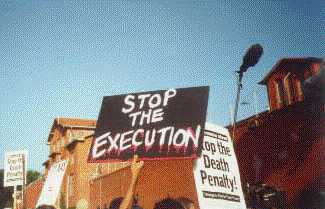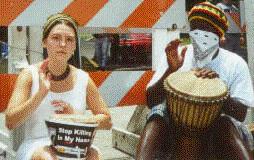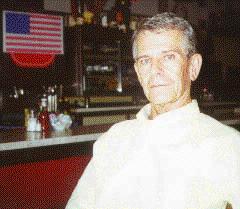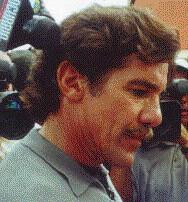A Long Day in the Capitol of Punishment

by John Tarleton
June 2000
HUNTSVILLE, Texas—It was sundown in this normally quiet East Texas town and the 19-year legal battle between Gary Graham and the State of Texas was about to culminate in the methodically organized killing of the condemned man. Designated witnesses, including Bianca Jagger and the Revs. Jesse Jackson and Al Sharpton, filed through the front entrance of the Walls Unit where Texas-style justice is meted out.
"Stop the legal lynching! Stop the legal lynching!" The sunburnt protesters chanted for the hundredth or thousandth time as they pressed against police barricades.
The prison's high, red brick walls loomed in front of them. Four choppers hovered overhead and a parking lot full of television trucks with mounted satellite dishes pointed upward to the heavens lent a strange, otherworldly air to the occasion.
It was a moment to take a deep breath and step back from the bedlam. The protesters' brave talk of building a movement seemed, for the moment, out of place. A man was about to die.
Gary Graham
Who was Gary Graham? One man crime wave, or innocent scapegoat for a crime he didn't commit? And, how did this 7th grade dropout from Houston's 5th Ward manage to rivet the eyes of the world on the Texas justice system?
Graham's legal odyssey began in May 1981with a series of burglaries and armed robberies that occurred at the same time that Bobby Grant Lambert, a 53-year-old Korea vet who enjoyed flying twin-engine airplanes, was shot in the head and killed outside a Safeway in north Houston. Eight days after the Lambert shooting, Graham was apprehended following the robbery/rape of a 57-year-old taxi driver.
During the subsequent police investigation, Bernadine Skillern was the only one of eight witnesses who identified Graham as Lambert's killer. While she had been sitting in her car 40 feet from the crime scene, Skillern said she had seen Graham's face for a couple of seconds with the aid of her headlights. Years later evidence would turn up about the flawed process for identifying the suspect in the Graham case.
Graham, then 17, was convicted of capital murder in October 1981 primarily on Skillern's testimony. There was no confession, no murder weapon, no evidence that Graham knew the victim or that he had taken any of his property (including $6,000 in cash that was found in Lambert's wallet), nor was there any physical evidence (fingerprints, blood, DNA or hair) linking Graham to the crime scene. Graham's court-appointed attorney (there is no public defenders' office in 251 of Texas's 254 counties) Ron Mock declined to conduct an investigation on his client's behalf and didn't call any witnesses during the two-day trial. Mock's lackluster defense would later have a huge impact on Graham's efforts to exonerate himself.
The Lonely Insurgents
About 60 of Graham's supporters gathered early on the morning of June 22 at the SHAPE community center near downtown Houston before convoying to Huntsville on a pair of charter busses. A last minute logistics meeting was interrupted by a cell phone call from someone in Detroit who had been fasting for a week. The New York Times and USA Today had come out that with editorials calling for a halt to Graham's execution. The 18-member Texas Board of Pardons and Paroles was scheduled to rule at noon on a petition for clemency.
 Graham's supporters at SHAPE contended that he had changed during his long incarceration. He had become a voracious reader, the editor of a prison newspaper and the author of a book (Let the Evidence Be Heard).
Graham's supporters at SHAPE contended that he had changed during his long incarceration. He had become a voracious reader, the editor of a prison newspaper and the author of a book (Let the Evidence Be Heard).
"Our brother has evolved over 19 years into a freedom fighter and a revolutionary," said Graham's spiritual advisor Robert Muhammad, an ebullient, rock solid man who had fasted for 30 days and was wearing a bright blue bow tie."Through his life, he has called the whole world to look at Texas. He represents everything we've marched for, chanted for, lost our jobs for and got arrested for."
Ghost Town
Rumors of violent protests preceded Graham's supporters. When they stepped off the air conditioned busses into the sweltering, blast furnace heat, they found a virtual ghost town. They drummed and chanted. They marched through the near empty streets around the Walker County Courthouse and then returned to their designated protest area on the west side of the Walls Unit. It was the first time in Huntsville's history that businesses had closed for an execution.
Mac, 46, a born again Christian who has lived around Huntsville his whole life, took in the scene from a bench in front of the courthouse. He claimed to be dumbfounded by the colorful rabble that had descended upon his hometown.
"Wasn't nobody ever put to death for singing too loud in a church choir," he said.
Mac suggested that Graham aim higher than the Supreme Court with his final appeal. "If he don't know Jesus by about 6 or 6:20, he's in trouble. (But) if he's right with God, he'll be at his right hand next to the throne," Mac said. "...I don't want to see nobody die, but some have to die. Full blooming flowers alone will not do. Some must be young and ungrown."
The Cafe Texan has been located across the street from the courthouse since 1936. John Strickland, 54, a soft-spoken Vietnam vet, took it over three years ago. He serves a mean chicken fried steak but still finds himself fighting for survival against the chain restaurants that have popped up on the edge of town out by I-45. For Strickland, there is more to Huntsville than its reputation as the Capitol of Punishment.
 He proudly points to the good hunting (white tail deer) and fishing (large mouth bass) in the nearby Sam Houston National Forest, the Sam Houston folk festival in early April, a harvest fair on the first Saturday of each October and a student community of 13,000 at Sam Houston State University.
He proudly points to the good hunting (white tail deer) and fishing (large mouth bass) in the nearby Sam Houston National Forest, the Sam Houston folk festival in early April, a harvest fair on the first Saturday of each October and a student community of 13,000 at Sam Houston State University.
Strickland's cafe was besieged two years ago when Karla Faye Tucker became the first Texas woman in over 100 years to be executed. Local yokels were invited to pontificate while waitresses could barely maneuver through the media hordes. Strickland closed early on the 22nd and was prepared to field all questions. He was leaving nothing to chance.
"East Coast media and out-of-state media look for the most redneck person they can to say something asinine that will go out all over the country," he said. "We're a mixed blend of people like everywhere else in this country. We have differing opinions on issues like capitol punishment and abortion."
 At 1:30 p.m., the Texas Board of Pardons and Paroles announced that it had rejected Graham's petition for clemency by a 12-5 vote. By Texas law, Governor George W. Bush could have granted Graham a reprieve only if the Board recommended it. However, the board members are all Bush appointees. They earn $75,000 per year, hold their meetings behind closed doors and make most of their decisions via fax and email.
At 1:30 p.m., the Texas Board of Pardons and Paroles announced that it had rejected Graham's petition for clemency by a 12-5 vote. By Texas law, Governor George W. Bush could have granted Graham a reprieve only if the Board recommended it. However, the board members are all Bush appointees. They earn $75,000 per year, hold their meetings behind closed doors and make most of their decisions via fax and email.
"They provide cover for Bush," said Rev. Jesse Jackson.
Surrounded by throngs of reporters, Jackson had just come from a prayer session with Graham and his stepmother Elnora Graham. They had read the 27th psalm ("The Lord is my refuge; of whom am I afraid?/When evildoers come at me to devour my flesh, these my enemies would themselves stumble and fall.") together. "He was amazingly calm. There were no tears," Jackson said. "He feels he's being used as a change agent to expose this system. The pain of Gary has put light in dark places."
Willie Ray was ready for Graham's sentence to be carried out. Ray, 48, a lanky bookseller from nearby Conroe stood on the east-side of the Walls Unit among death penalty supporters. He held a Confederate flag in his right hand and a sign ("Die N-Word! Die!") in his left.
"I think it's time to do it after 19 years," Ray said. "…I'm absolutely appalled at the media coverage he is getting. I don't know how he became such a celebrity."
Ray said that he had not read any of the details of the case and that he trusted the judicial system to do the right thing. "I think our justice system is the best in the world," he said. "Of course, no system is perfect. But, ours is good enough."
New Evidence
Graham's efforts to exonerate himself received a boost in 1993 when Houston attorneys Jack Zimmerman and Richard Burr took on his case.. For the first time, the defense conducted a full investigation of the case.
Graham's lawyers noticed that his facial features looked nothing like those of the man depicted in the original police composite sketch which Bernadine Skillern, among others, had contributed to. Two former Safeway employees, Sherian Etuk and Ronald Hubbard, who both had seen the killer lurking outside the store minutes before the shooting, came forward and stated that the assailant as being between 5'3" and 5'5". Graham was 5'9" at the time. Neither Etuk nor Hubbard was called to testify in the original trial.
"He (Graham) is not the person I saw that night," Hubbard said "They will be putting an innocent man to death." (Houston Chronicle June 18, 2000)
Skillern originally selected Graham, after some initial hesitation, from a photo album in which Graham was the only man pictured with a short Afro and no facial hair. Later, at a police lineup, Graham was the only one of five men on stage whose picture had appeared in the photo album. And, Skillern again identified him as the killer. Hubbard watched the same lineup and told police that the killer was not present.
As for Lambert, he had been arrested in October 1980 in Oklahoma City while flying a plane carrying 40,000 Quaaludes and several ounces of cocaine. Besides the $6,000 in his wallet, police found marijuana, several guns and a variety of drivers licenses in his van. (Houston Chronicle June 18, 2000)
Graham's legal team would spend the next seven years trying to find a court that would review new evidence in the case. Graham had already burned up his initial federal habeas corpus appeal years before. And by Texas law, new evidence can only be presented on appeal within 30 days of conviction. Though Graham would make 33 appeals and receive seven stays of execution while on Death Row, the courts would not grant him a new evidentiary hearing much less a new trial. Time was running out.
Sundown
 A cheer went up at 5:30 p.m. Graham's lethal injection was scheduled for 6:03 p.m. but the US Supreme Court had issued a temporary stay of execution. The Rehnquist Court has strongly supported the death penalty. But by now, Graham's case was drawing huge national and international coverage. Anthony Freddie, coordinator of the Houston Area Gary Graham Coalition was still hopeful.
A cheer went up at 5:30 p.m. Graham's lethal injection was scheduled for 6:03 p.m. but the US Supreme Court had issued a temporary stay of execution. The Rehnquist Court has strongly supported the death penalty. But by now, Graham's case was drawing huge national and international coverage. Anthony Freddie, coordinator of the Houston Area Gary Graham Coalition was still hopeful.
"I believe that every person should get an equal chance to prove theirself innocent," Freddie said. "There should not be any limitation to proving yourself innocent. I don't care that it's 20 or 30 years. A person should always have that right."
A couple of hours later, the Supreme Court vacated the temporary stay by a vote of 5-4. A last ditch appeal was launched to the Texas Civil Court alleging that the process used by the Texas Board of Pardons and Paroles was unlawful. The appeal was denied. Jackson, Jagger, Sharpton and Thomas Muhammad then entered the Walls Unit. Shortly thereafter, they were followed by four witnesses for the victim, each seeking "closure".
Graham maintained his innocence until the end. He was moved by force from his cell to the death chamber. During the altercation, he tore the paper uniform he was wearing. After delivering a final statement("...We will prevail. Keep marching. Black power. Keep marching. Black power. They are killing me tonight. They are murdering me tonight."), he was strapped to a gurney with an additional restraint around his head. A lethal mixture of Sodium Pentothal was injected into one of the veins in his arm. He coughed and choked and then lost consciousness. He was pronounced dead at 8:49 p.m. According to newspaper reports he died with one eye open, facing the witnesses.
Back to On the Road with John Tarleton